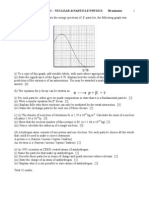0 ratings0% found this document useful (0 votes)
24 viewsPHY3 DJune 2006
PHY3 DJune 2006
Uploaded by
api-3726022This document contains information about medical physics topics related to radioactive decay, X-ray tubes, and ultrasound diagnosis. It includes:
1) Graphs showing the radioactive decay of technetium-99m which has a half-life of 6 hours, and asks questions about calculating the biological half-life from another graph.
2) Questions about the nuclear decay processes of molybdenum-94 to technetium-99m, and technetium-99m to its stable product, including writing nuclear equations.
3) Questions about how X-ray absorption depends on atomic number Z and the labeled parts and functions of an X-ray tube.
4) Questions defining variables in
Copyright:
Attribution Non-Commercial (BY-NC)
Available Formats
Download as DOC, PDF, TXT or read online from Scribd
PHY3 DJune 2006
PHY3 DJune 2006
Uploaded by
api-37260220 ratings0% found this document useful (0 votes)
24 views1 pageThis document contains information about medical physics topics related to radioactive decay, X-ray tubes, and ultrasound diagnosis. It includes:
1) Graphs showing the radioactive decay of technetium-99m which has a half-life of 6 hours, and asks questions about calculating the biological half-life from another graph.
2) Questions about the nuclear decay processes of molybdenum-94 to technetium-99m, and technetium-99m to its stable product, including writing nuclear equations.
3) Questions about how X-ray absorption depends on atomic number Z and the labeled parts and functions of an X-ray tube.
4) Questions defining variables in
Original Title
PHY3DJune2006
Copyright
© Attribution Non-Commercial (BY-NC)
Available Formats
DOC, PDF, TXT or read online from Scribd
Share this document
Did you find this document useful?
Is this content inappropriate?
This document contains information about medical physics topics related to radioactive decay, X-ray tubes, and ultrasound diagnosis. It includes:
1) Graphs showing the radioactive decay of technetium-99m which has a half-life of 6 hours, and asks questions about calculating the biological half-life from another graph.
2) Questions about the nuclear decay processes of molybdenum-94 to technetium-99m, and technetium-99m to its stable product, including writing nuclear equations.
3) Questions about how X-ray absorption depends on atomic number Z and the labeled parts and functions of an X-ray tube.
4) Questions defining variables in
Copyright:
Attribution Non-Commercial (BY-NC)
Available Formats
Download as DOC, PDF, TXT or read online from Scribd
Download as doc, pdf, or txt
0 ratings0% found this document useful (0 votes)
24 views1 pagePHY3 DJune 2006
PHY3 DJune 2006
Uploaded by
api-3726022This document contains information about medical physics topics related to radioactive decay, X-ray tubes, and ultrasound diagnosis. It includes:
1) Graphs showing the radioactive decay of technetium-99m which has a half-life of 6 hours, and asks questions about calculating the biological half-life from another graph.
2) Questions about the nuclear decay processes of molybdenum-94 to technetium-99m, and technetium-99m to its stable product, including writing nuclear equations.
3) Questions about how X-ray absorption depends on atomic number Z and the labeled parts and functions of an X-ray tube.
4) Questions defining variables in
Copyright:
Attribution Non-Commercial (BY-NC)
Available Formats
Download as DOC, PDF, TXT or read online from Scribd
Download as doc, pdf, or txt
You are on page 1of 1
PHY3 JUNE 2006 - TOPIC D - MEDICAL PHYSICS 30 minutes 1
4. (a) Graph R shows the radioactive
decay of technetium 99mTc which
has a radioactive half-life of 6 hours.
Graph E shows the observed decay
of the same isotope when it is used
in a tracer investigation in a patient.
(i) On a copy of this graph, label
the x-axis. [1]
(ii) Use graph R to add a scale and units
to the x-axis. Show how you did this on
your copy of the graph. [2]
Use graph E to calculate the biological half-life
of the isotope in this investigation. [3]
(b) (i) Molybdenum 9042Mo decays to 99mTc by beta-minus emission.
Write a balanced nuclear equation for this decay. [1]
(ii) In what is radioactive molybdenum produced? [1]
(iii) Describe and explain the process of elution that is used to extract the 99mTc from an elution cell.
You may be awarded a mark for the clarity of your answer. [4]
(iv) Technetium 99mTc decays by gamma emission.
Write a balanced nuclear equation
for this decay. [1]
(v) The product of this decay has a
half-life of 210 000 years.
Explain the importance of this
long half-life when 99mTc is
used as a tracer. [2]
(c) In X-ray diagnosis the
absorption of keV X-rays is
highly dependent on Z.
(i) State what Z represents in this context. [1]
(ii) Explain the relevance of the value of Z
in the production of radiographic images. [2]
The diagram shows a rotating anode X-ray tube.
(iii) Name and explain the function of the numbered parts
of the X-ray tube. [6]
(d) In ultrasonic diagnosis the reflection coefficient a can be written as:
(i) State what is represented by Z1 and Z2 in this equation. [2]
(ii) Show that the units of Z are kg m2 s-1. [2]
(iii) Calculate the reflection coefficient using the data
given opposite. [2]
(iv) Hence find the percentage of the incident ultrasound that
will be transmitted through a muscle-blood boundary. [2]
Total 32 marks
You might also like
- PHY3 DJanuary 2002Document1 pagePHY3 DJanuary 2002api-3726022No ratings yet
- phy-S5-Atomic PhysicsDocument15 pagesphy-S5-Atomic PhysicsY AdaNo ratings yet
- AL Essays (Radioactivity, Light & Electrons) - 1Document7 pagesAL Essays (Radioactivity, Light & Electrons) - 1umpc1248No ratings yet
- Physics Seminar IIDocument9 pagesPhysics Seminar IImundu mustafaNo ratings yet
- 1999 AL Phy Paper 1Document9 pages1999 AL Phy Paper 1KelvinNgNo ratings yet
- BUET PHY 121 Merged TF - 2010-11 to 2021-22Document31 pagesBUET PHY 121 Merged TF - 2010-11 to 2021-22tafhimul25No ratings yet
- Itutor Fortnightly Test Series: Subjective Test - 1 (H.A.)Document4 pagesItutor Fortnightly Test Series: Subjective Test - 1 (H.A.)Debangsu GhoshNo ratings yet
- 2024 Board QPDocument11 pages2024 Board QPnihal241234No ratings yet
- FORM TP 21228: Caribbean Examinations Counci Advanced Proficiency Examination Physics UNIT 02 - Paper 0LDocument18 pagesFORM TP 21228: Caribbean Examinations Counci Advanced Proficiency Examination Physics UNIT 02 - Paper 0LRaymond ScottNo ratings yet
- 16 Nov 2024Document9 pages16 Nov 2024metoli9526No ratings yet
- PHY3 CJune 2006Document1 pagePHY3 CJune 2006api-3726022No ratings yet
- Section C Physics Paper 1 Revision Questions For A LevelDocument24 pagesSection C Physics Paper 1 Revision Questions For A LevelzakNo ratings yet
- 6 RadioactiveDocument9 pages6 RadioactiveAnna Latifah CammryNo ratings yet
- PHY3 DJune 2004Document1 pagePHY3 DJune 2004api-3726022No ratings yet
- SCI-1-MAR-2023-AP (1)Document9 pagesSCI-1-MAR-2023-AP (1)vishal yadavNo ratings yet
- Basic ElectronicsDocument18 pagesBasic ElectronicsGrace jereNo ratings yet
- Uganda Certificate of Education: Physics Paper 2 Time: 2 Hours 15 MinutesDocument8 pagesUganda Certificate of Education: Physics Paper 2 Time: 2 Hours 15 MinutesTawshir EmperorNo ratings yet
- Physics Practice Paper-2Document7 pagesPhysics Practice Paper-2Parul guptaNo ratings yet
- STPM Trials 2009 Physics Paper 2 (SMJK Sam Tet Ipoh)Document8 pagesSTPM Trials 2009 Physics Paper 2 (SMJK Sam Tet Ipoh)Foo ShiyauNo ratings yet
- Physics Ppe Paper 1 HWDocument35 pagesPhysics Ppe Paper 1 HWKirsten AntonioNo ratings yet
- ModelPapers MODELPAPER10 Physics12Document1 pageModelPapers MODELPAPER10 Physics12Maulik KarasaliyaNo ratings yet
- Physics Model QuestionsDocument20 pagesPhysics Model Questionskarki.prdp1991No ratings yet
- RadioactivityDocument15 pagesRadioactivityBenjamin Teo0% (2)
- Physics Sample Paper6Document7 pagesPhysics Sample Paper6Shikha kathuria physicsNo ratings yet
- Physics Set 10Document10 pagesPhysics Set 10bijayakumal819No ratings yet
- H7 Physics Prelim- Exam 2014- X (M).Document5 pagesH7 Physics Prelim- Exam 2014- X (M).ssssshikharrNo ratings yet
- Section A: Answer All Questions (40 Marks)Document11 pagesSection A: Answer All Questions (40 Marks)c3mutNo ratings yet
- Premier XII Set BDocument3 pagesPremier XII Set Bsubb99000No ratings yet
- 2019 Quantum Electronics PaperDocument3 pages2019 Quantum Electronics PaperMargaret IrunguNo ratings yet
- Cy0u10a R Engineering Chemistry Sept 2022Document2 pagesCy0u10a R Engineering Chemistry Sept 2022kangirene9705No ratings yet
- 9702 Nos SP 4Document24 pages9702 Nos SP 4nanio_7No ratings yet
- Radioactivity QuestionDocument16 pagesRadioactivity QuestionVanusha AzzrielNo ratings yet
- St. Joseph'S Ss Kakindu: Uace Resource Mock ExaminationsDocument10 pagesSt. Joseph'S Ss Kakindu: Uace Resource Mock ExaminationsAinebyoona ChriscentNo ratings yet
- Kimss Seminar Uace Physics 2023Document11 pagesKimss Seminar Uace Physics 2023www.jacobpatienceNo ratings yet
- 3.-T7-2 T-CuestionesDocument46 pages3.-T7-2 T-CuestionesAnonymous zP1ek3ya5nNo ratings yet
- UACE KCB MOCK Phy2 PDFDocument8 pagesUACE KCB MOCK Phy2 PDFTRIPPLE KAYZ UGNo ratings yet
- Cape 2003 Unit 1 Paper 2Document12 pagesCape 2003 Unit 1 Paper 2petey78No ratings yet
- 6.test Mix 2 (1h)Document4 pages6.test Mix 2 (1h)Duncan LinNo ratings yet
- Rr411812 X Ray MetallographyDocument5 pagesRr411812 X Ray MetallographySRINIVASA RAO GANTANo ratings yet
- DUAL NATURE OF MATTER AND RADIATION AND WAVE OPTICS TEST XII 27.11.24Document2 pagesDUAL NATURE OF MATTER AND RADIATION AND WAVE OPTICS TEST XII 27.11.24jharnalahiri2No ratings yet
- S.6 Phy p2 Lubiri Test22Document7 pagesS.6 Phy p2 Lubiri Test22kayiwaabdulrahman1No ratings yet
- ExercisesDocument13 pagesExercisesAhmed Magdy Beshr100% (1)
- 5054 MJ 2023 P21Document15 pages5054 MJ 2023 P21Raahin RahimNo ratings yet
- Xii Phy Set-I QPDocument11 pagesXii Phy Set-I QPunclegojo86No ratings yet
- A GCE Physics B 2865 01 January 2006 Question PaperDocument24 pagesA GCE Physics B 2865 01 January 2006 Question PaperMitul KaziNo ratings yet
- Eletronic and RadioactiveDocument16 pagesEletronic and RadioactiveShiu Ping WongNo ratings yet
- Physics Set 7Document5 pagesPhysics Set 7bijayakumal819No ratings yet
- 4 Practice Set-12Document20 pages4 Practice Set-12paudelkshitiz413No ratings yet
- Scan 22 Feb 2022Document3 pagesScan 22 Feb 2022Aditya KavalanekarNo ratings yet
- ICSE Physics Paper 8 - 2024-25Document5 pagesICSE Physics Paper 8 - 2024-25pardeshiomkar460No ratings yet
- This Paper Has 6 Printed Pages. 1Document6 pagesThis Paper Has 6 Printed Pages. 1shiva priyaNo ratings yet
- Minimum Learning Material (XII)Document6 pagesMinimum Learning Material (XII)Abhi VarnaNo ratings yet
- ICSE Board Class X Physics Gold Series Sample Paper - 4: Time: 1 Hrs Total Marks: 80 General InstructionsDocument16 pagesICSE Board Class X Physics Gold Series Sample Paper - 4: Time: 1 Hrs Total Marks: 80 General InstructionsArijit Das GuptaNo ratings yet
- (Three Hours) : Sample Paper - 2011 Class - XII Subject - PhysicsDocument5 pages(Three Hours) : Sample Paper - 2011 Class - XII Subject - PhysicsValay DaveNo ratings yet
- Jurong Junior College: JC2 Common Test 2 2015Document25 pagesJurong Junior College: JC2 Common Test 2 2015Chen ZhihaoNo ratings yet
- Be - First Year Fe Engineering - Semester 2 - 2019 - November - Engineering Physics Pattern 2015Document4 pagesBe - First Year Fe Engineering - Semester 2 - 2019 - November - Engineering Physics Pattern 2015amkslade101No ratings yet
- Behaviors and Persistence of Nanomaterials in Biomedical ApplicationsFrom EverandBehaviors and Persistence of Nanomaterials in Biomedical ApplicationsNo ratings yet
- Exposure Assessment and Safety Considerations for Working with Engineered NanoparticlesFrom EverandExposure Assessment and Safety Considerations for Working with Engineered NanoparticlesNo ratings yet
- Biojune 2008 U4aqDocument24 pagesBiojune 2008 U4aqapi-3726022100% (1)
- PHY3 DJanuary 2004Document1 pagePHY3 DJanuary 2004api-3726022No ratings yet
- 6102 01 Que 20080109Document20 pages6102 01 Que 20080109Inas ManurungNo ratings yet
- Biojune 2008 U1qDocument16 pagesBiojune 2008 U1qapi-3726022No ratings yet
- Unit 1 Exam Jan 2002Document16 pagesUnit 1 Exam Jan 2002Öykü TuralNo ratings yet
- Biology Jan 2008 6101 QuestionDocument20 pagesBiology Jan 2008 6101 QuestionAdrees MeahNo ratings yet
- PHY3 DJune 2004Document1 pagePHY3 DJune 2004api-3726022No ratings yet
- PHY3 DJune 2002Document1 pagePHY3 DJune 2002api-3726022No ratings yet
- PHY3 DJune 2005Document1 pagePHY3 DJune 2005api-3726022No ratings yet
- PHY3 DJanuary 2005Document1 pagePHY3 DJanuary 2005api-3726022No ratings yet
- PHY3 CJanuary 2005Document1 pagePHY3 CJanuary 2005api-3726022No ratings yet
- PHY3 CJune 2006Document1 pagePHY3 CJune 2006api-3726022No ratings yet
- PHY3 CJune 2004Document1 pagePHY3 CJune 2004api-3726022No ratings yet
- PHY3 CJune 2002Document1 pagePHY3 CJune 2002api-3726022No ratings yet
- PHY3 AJune 2005Document1 pagePHY3 AJune 2005api-3726022No ratings yet
- PHY3 CJanuary 2006Document1 pagePHY3 CJanuary 2006api-3726022No ratings yet
- PHY3 AJune 2004Document1 pagePHY3 AJune 2004api-3726022No ratings yet
- PHY3 CJanuary 2003Document1 pagePHY3 CJanuary 2003api-3726022No ratings yet
- PHY3 AJune 2003Document1 pagePHY3 AJune 2003api-3726022No ratings yet
- PHY3 AJune 2006Document1 pagePHY3 AJune 2006api-3726022No ratings yet
- PHY3 AJanuary 2006Document1 pagePHY3 AJanuary 2006api-3726022No ratings yet
- PHY3 AJanuary 2004Document1 pagePHY3 AJanuary 2004api-3726022No ratings yet















































































